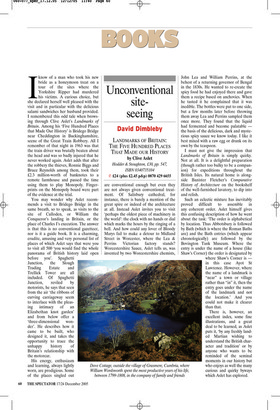Unconventional
site
seeing
David Dimbleby
LANDMARKS OF BRITAIN: THE FIVE HUNDRED PLACES THAT MADE OUR HISTORY by Clive Aslet Hodder & Stoughton, £30, pp. 547, ISBN 0340735104 ✆ £24 (plus £2.45 p&p) 0870 429 6655 Iknow of a man who took his new bride as a honeymoon treat on a tour of the sites where the Yorkshire Ripper had murdered his victims. A curious choice, but she declared herself well pleased with the visit and in particular with the delicious salami sandwiches her husband provided. I remembered this odd tale when browsing through Clive Aslet’s Landmarks of Britain. Among his ‘Five Hundred Places that Made Our History’ is Bridego Bridge near Cheddington in Buckinghamshire, scene of the Great Train Robbery. All I remember of that night in 1963 was that the train driver was brutally beaten about the head and was so badly injured that he never worked again. Aslet adds that after the robbery the thieves, Ronnie Biggs and Bruce Reynolds among them, took their £2.3 million-worth of banknotes to a remote farmhouse and passed the time using them to play Monopoly. Fingerprints on the Monopoly board were part of the evidence at the trial.
His energy, enthusiasm and learning, always lightly worn, are prodigious. Some of the places singled out are conventional enough but even they are not always given conventional treatment. Of Salisbury cathedral, for instance, there is barely a mention of the great spire or indeed of the architecture at all. Instead Aslet invites you to visit ‘perhaps the oldest piece of machinery in the world’: the clock with no hands or dial which marks the hours by the ringing of a bell. And how could any lover of Bloody Marys fail to make a detour to Midland Street in Worcester, where the Lea & Perrins Victorian factory stands? Worcestershire Sauce, Aslet tells us, was invented by two Worcestershire chemists, John Lea and William Perrins, at the behest of a returning governor of Bengal in the 1830s. He wanted to re-create the spicy food he had enjoyed there and gave them a recipe based on anchovies. When he tasted it he complained that it was inedible. The bottles were put to one side, but a few months later before throwing them away Lea and Perrins sampled them once more. They found that the liquid had fermented and become palatable the basis of the delicious, dark and mysterious spicy sauce we know today. I like it best mixed with a raw egg or drunk on its own by the teaspoon.
I must not give the impression that Landmarks of Britain is simply quirky. Not at all. It is a delightful preparation (though rather too bulky to be a companion) for expeditions throughout the British Isles. Its natural home is alongside Banister Fletcher’s Comparative History of Architecture on the bookshelf of the well-furnished lavatory, to dip into and relish.
Such an eclectic mixture has inevitably proved difficult to assemble in any coherent order. Aslet himself gives this confusing description of how he went about the task: ‘The order is alphabetical by location. Thus Abbotsbury is followed by Bath (which is where the Roman Baths are) and the Bath entries (which appear chronologically) are followed by the Bovington Tank Museum. Where the entry is under the name of a house (like Shaw’s Corner) the order is designated by where Shaw’s Corner is in this case Ayot St Lawrence. However, where the name of a landmark is “near” a town or village rather than “in” it, then the entry goes under the name of the landmark and not the location.’ And you could not make it clearer than that.
There is, however, an excellent index, some fine illustrations, and a great deal to be learned, as Aslet puts it, ‘by any freshly landed Martian wishing to understand the British character and tradition’ or by anyone who wants to be reminded of the seminal moments in our history but who enjoys as well the many curious and quirky byways which Aslet has explored.


















































































 Previous page
Previous page